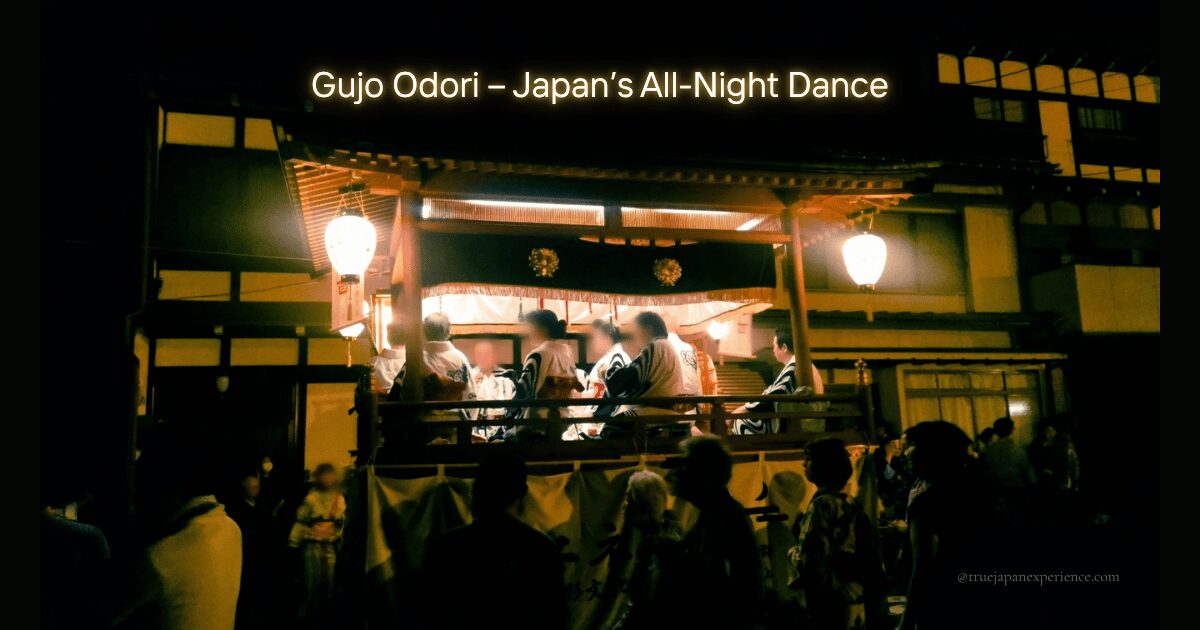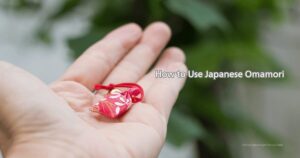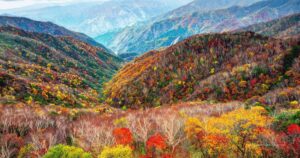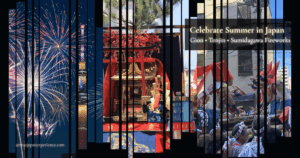Gujo Odori isn’t flashy. It doesn’t have huge fireworks or grand parades.
But when my husband and I joined the dance, we found something even more special.
There was a quiet joy in becoming part of the circle, dancing alongside strangers dressed in colorful yukata, all moving together to the same gentle rhythm.
The rhythm, the smiles, the sounds of geta on stone—everything felt nostalgic, even though it was our first time. We want to share this festival because it left a lasting impression on us. It’s one of the few summer festivals we truly want to visit again.
If you’re looking for a local experience that brings people together, Gujo Odori is the one.
What Is Gujo Odori?
Gujo Odori is a traditional summer dance festival held in Gujo Hachiman, a charming riverside town in Gifu Prefecture.
Dating back over 400 years, it is considered one of Japan’s three major Bon Odori festivals and was recognized by UNESCO as an Intangible Cultural Heritage in 2022.
Unlike many festivals where visitors simply watch from the sidelines, Gujo Odori invites everyone to join the circle—locals, travelers, children, and even first-time dancers.
The movements are simple and repetitive, allowing even complete beginners to take part without hesitation. It’s not about performance, but about shared joy and rhythm.
The festival stretches across over 30 nights, from mid-July to early September.
During the peak season—the famous “Tetsuya Odori” from August 13 to 16—dancing continues all night long, from dusk till dawn. Streets come alive with the sound of wooden geta sandals, the echo of live music, and the glow of paper lanterns.
More than just a festival, Gujo Odori is a living tradition passed down through generations. It blends community spirit, seasonal beauty, and cultural pride into a one-of-a-kind experience.
Whether you’re a curious traveler or a lover of Japanese culture, joining Gujo Odori is like stepping into the heart of summer in Japan.
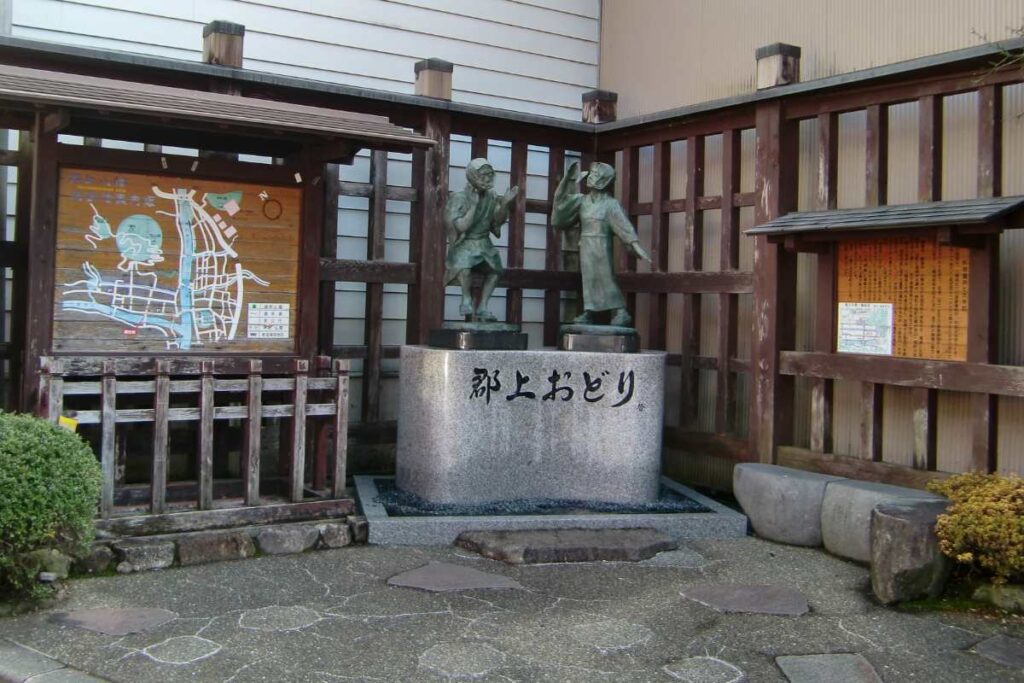
This monument in Gujo Hachiman honors the spirit of Gujo Odori, with statues of dancers welcoming all who visit the town.
Key Features of Gujo Odori
Gujo Odori is not just a one-night event—it’s a cherished summer tradition that takes place from mid-July to early September in the historic town of Gujo Hachiman.
For nearly two months, the town comes alive with the sound of music and dancing, as locals and visitors gather night after night to share in the joy of movement.
Here are some of the most distinctive and memorable features that make this festival one-of-a-kind.
● A Festival That Lasts All Summer
Gujo Odori is held over an incredible stretch of nearly 30 nights, starting in mid-July and continuing until early September. This makes it one of the longest-running traditional dance festivals in Japan.
The true highlight is the Tetsuya Odori, or “All-Night Dance,” held annually from August 13 to 16, during the Obon holiday.
On these four nights, the dancing never stops—people move through the streets in a rhythmic circle from sunset until sunrise, fueled by music, community spirit, and a shared love for tradition.
Dancing until dawn under paper lanterns, with the sounds of geta echoing through the streets, creates an unforgettable summer night that feels timeless.
● Open to All: No Experience Needed
One of the most beautiful aspects of Gujo Odori is its openness. There are no gates, no admission fees, and no rules about who can join. All you have to do is step into the circle.
The dance steps are simple and repetitive, intentionally designed so that anyone—even first-time visitors—can join with ease. Locals are friendly and often help newcomers learn the moves on the spot.
We ourselves joined without knowing any steps, yet we felt instantly welcomed. There’s no pressure to “perform”—the joy is in moving together, sharing the rhythm, and smiling with strangers who quickly start to feel like neighbors.
● A Living Summer Tradition
For over 400 years, Gujo Odori has been more than just a festival—it’s a seasonal ritual and a symbol of connection between people and generations.
This is a tradition where grandparents teach their grandchildren to dance, where returning visitors reunite with friends, and where travelers become part of the story by simply stepping in.
The dance acts as a bridge between past and present, and between local culture and global visitors.
As the sun sets and the town fills with the sounds of flutes, drums, and joyful laughter, you don’t just witness Japanese culture—you become part of it.
Why You Should Join Gujo Odori
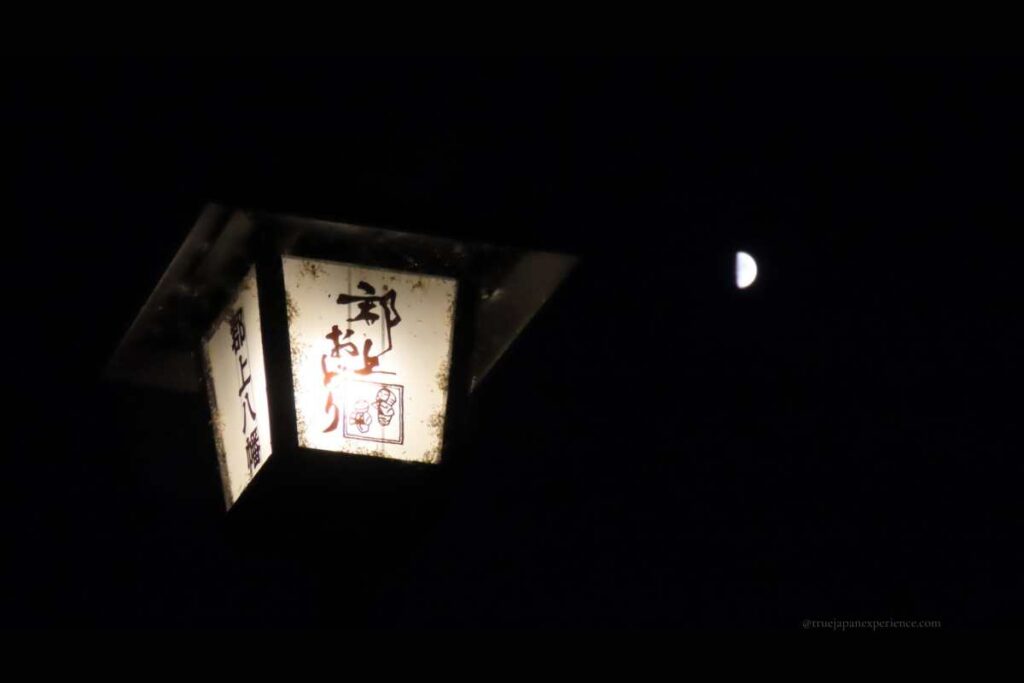
If you’re planning a summer trip to Japan, Gujo Odori is one experience we truly recommend—not because it’s famous or flashy, but because it’s something you feel with your whole body and heart.
Here’s why we believe you should take that step into the dance circle.
● You Don’t Just Watch—You Belong
Gujo Odori is not a stage performance. It’s a dance that welcomes you in. You don’t need to buy a ticket or sit on the sidelines.
Instead, you’re part of the circle. Locals will smile, gesture, and guide you through the steps—even if it’s your first time.
We joined without knowing a single move. Within minutes, we were dancing with people we’d never met, laughing, sweating, and feeling more connected to Japan than ever before.
● A Deep Cultural Experience—Made Simple
This is a tradition that’s been passed down for over 400 years. But it doesn’t feel formal or stiff.
The steps are easy.
The music is alive. And the rhythm is something anyone can follow.
It’s rare to find a cultural experience that is both so authentic and so accessible.
● The Magic of Dancing Through the Night
During the Tetsuya Odori, the streets are filled with dancers from dusk to dawn.
Paper lanterns glow above your head, geta sandals echo across the stone streets, and music drifts through the summer night.
It’s exhausting and exhilarating at the same time—and totally unforgettable.
You’ll sweat, you’ll smile, and you’ll wish the night would never end.
● It Happens in One of Japan’s Most Beautiful Towns
Gujo Hachiman isn’t just a backdrop—it’s part of the experience.
The Edo-era streets, gentle streams, and historical buildings turn the festival into something cinematic.
Whether you’re dancing or taking a break, every corner of this town adds to the magic.
Tips to Enjoy Gujo Odori Like a Local
Gujo Odori is already a welcoming festival—but with just a little preparation, your experience can become even more immersive, comfortable, and memorable.
From what to wear to how to learn the dances, here are our top tips to make the most of your night in the circle.
These are the things we wish we had known before we went—and the reasons we’d love to go back and do it all over again.
1. Wear a Yukata (Summer Kimono)

Wearing a yukata adds to the joy of joining a Japanese summer dance. Rental options are often available in festival towns like Gujo Hachiman.
You don’t need to dress up to join the dance—but wearing a yukata truly adds to the magic.
The sound of the fabric swaying as you move, the glow of lanterns against colorful patterns… it transforms the atmosphere.
There are rental shops in town that offer yukata sets and even help with dressing.
Just remember: summer nights can be hot, and dancing will make you sweat! Bring a change of clothes so you can freshen up afterward.
2. Dance in Wooden Geta Sandals
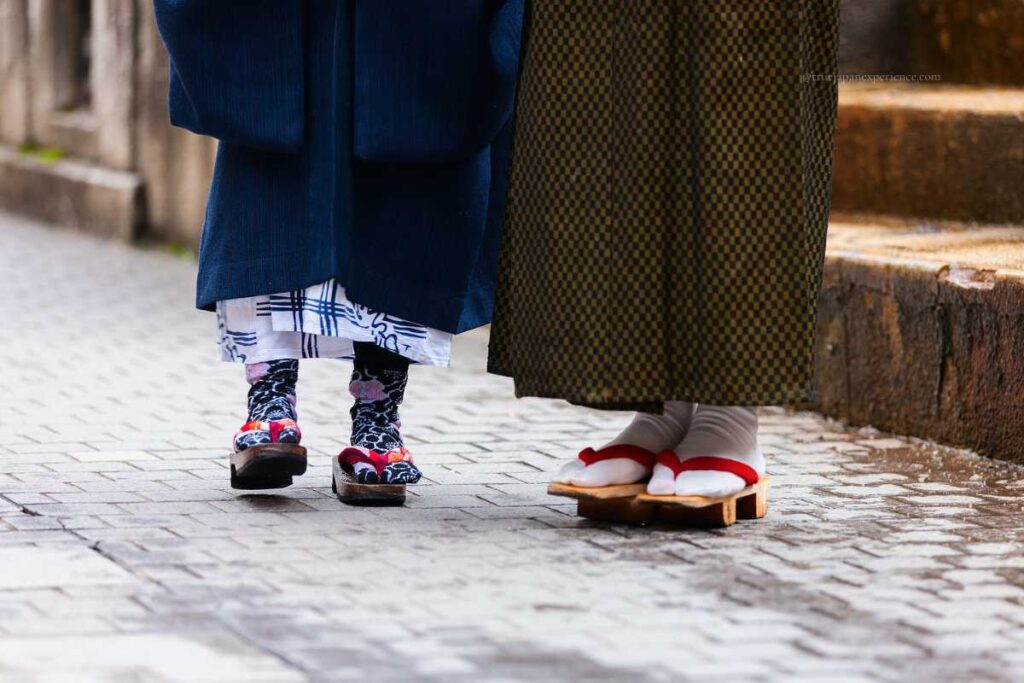
Wearing wooden geta adds rhythm to every step—join the dance and let the sound become part of the festival.
The “kan-kan” sound of wooden geta hitting the pavement is part of the festival’s rhythm.
Locals often say that Gujo Odori isn’t complete without the sound of geta.
Even better—some shops in Gujo Hachiman let you custom-fit a pair of geta to your feet. A unique souvenir you can wear!
3. Bring or Buy a Tenugui Towel
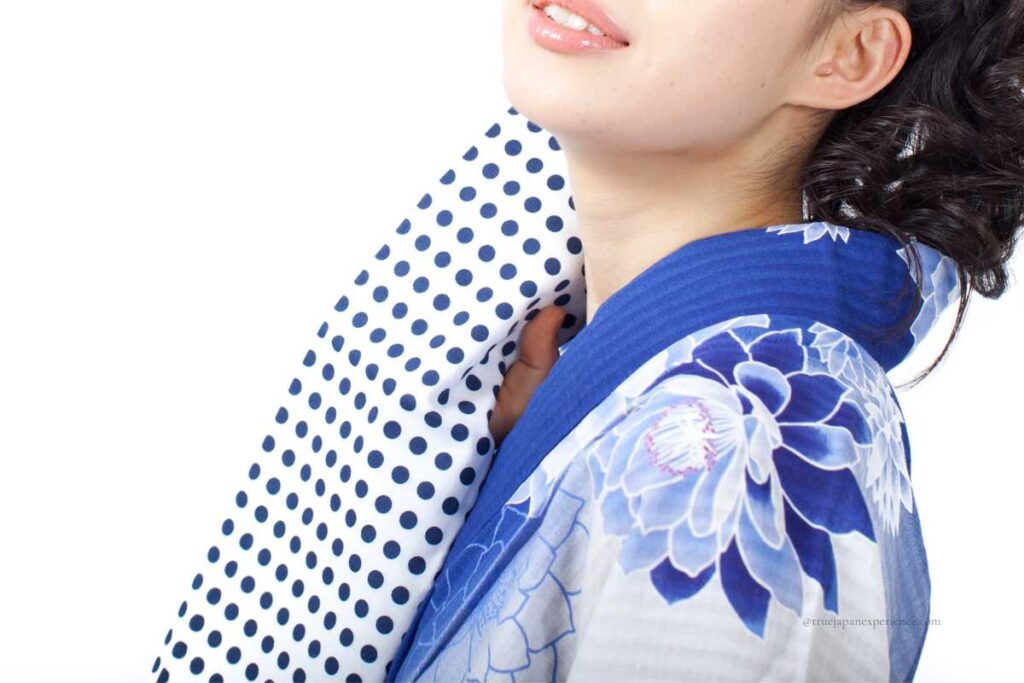
A tenugui towel is both stylish and useful—wear it around your neck or waist and join the dance like a local.
Many dancers wear a tenugui towel around the neck or tucked into the obi (belt).
It’s both practical and symbolic—used to wipe sweat or wave with rhythm, and a stylish way to show you’re part of the group.
Look for limited-edition designs sold during the festival. They make great mementos of your night.
4. Join a Dance Workshop
Not sure how to dance?
Don’t worry! There are short workshops and beginner-friendly lessons available throughout the festival season.
But honestly, you don’t even need them.
We joined on a whim, without knowing a single move. Locals smiled, gestured, and danced with us. That shared energy is what makes Gujo Odori so special.
5. Explore the Town During the Day
Gujo Hachiman is worth exploring in the daylight.
The Edo-era streets, peaceful canals, and traditional buildings feel like something out of a movie.
Taste cold soba made with local spring water, try grilled ayu fish, or enjoy a meal with famous Hida beef before you dance the night away.
6. Use Multilingual Support
Tourist centers and festival sites provide information in English, Chinese, and French, making it easy for international visitors to understand the schedule and traditions.
You can even preview the dances online before you arrive:
📺 Watch the dance in action
Tip: The festival takes place between mid-July and early September, but not every night. Also, the location changes from night to night, depending on the date.
Before your visit, be sure to check the official schedule so you know exactly when and where to join the dance.
📅 View the official dance calendar
The Tetsuya Odori is held every year from August 13 to 16—same dates every year, regardless of weekday. This is the peak of the festival and when the town is most crowded.
Where to Stay for Gujo Odori
If you want to enjoy Gujo Odori, finding the right place to stay is very important—especially during the Tetsuya Odori, the famous all-night dance held from August 13 to 16.
Many people come to the town during this time, and hotels and guesthouses become full very fast.
Here are some easy tips to help you choose the best place to stay and enjoy the festival more.
● Stay Close to the Dance Area
The dance takes place in different areas each night. Also, there is no dancing every single night, so you need to check the schedule before you go.
👉 Check the festival calendar here
If you can find a place to stay near the dance area, it will be much easier. You can walk there, take a short rest if you get tired, and you don’t have to worry about buses or trains at night.
● Book Early for August 13–16
The nights of August 13 to 16 are the most popular. This is when people dance all night. Many people come to Gujo Hachiman just for this, so you should book your room early if you want to join.
Some places have a small bus (shuttle) to take you to the dance, but staying close is still the easiest.
● Want to Wear a Yukata? Rent One in Town
Most inns give guests a yukata to wear in the room. But these are not made for dancing.
If you want to wear a real yukata and join the dance in full style, it’s better to rent one from a shop in town.
If you want to rent a yukata for dancing, some places to stay can help you find a good rental shop. Just ask them before you go.
● Our Experience
We stayed at a small inn that was just a few minutes’ walk from the dance.
It was very easy to get to the festival and come back to rest. We danced in regular clothes, and it was totally fine—everyone was kind, and we felt very welcome.
Explore Gujo Hachiman: Historic Streets, Waterways, and Local Flavors
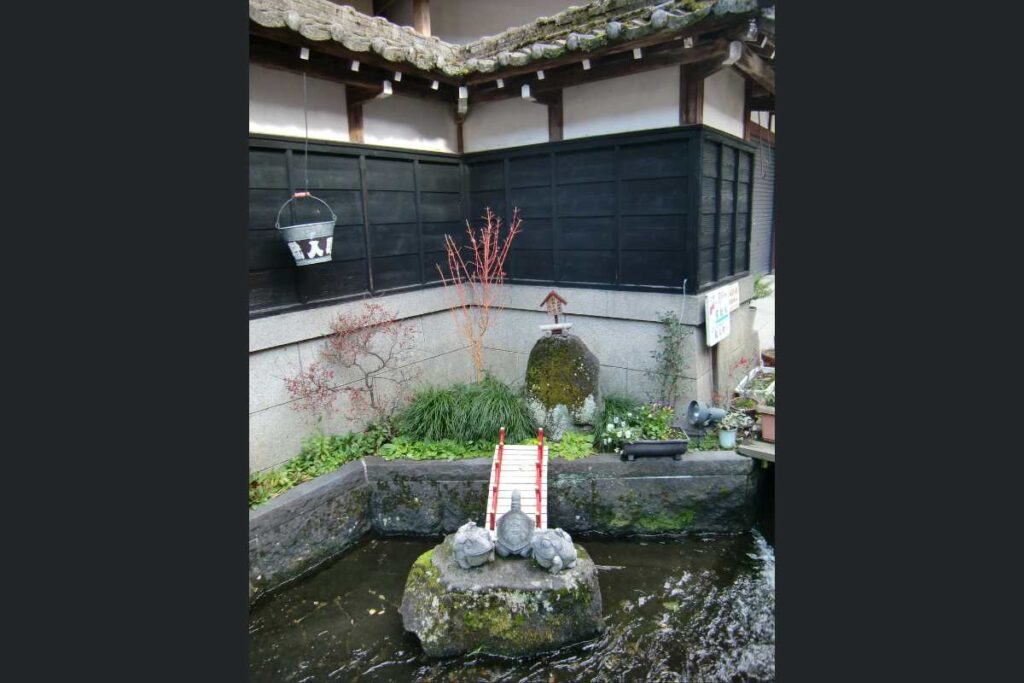
Sogi-sui is one of Japan’s most famous natural springs—a peaceful spot that reflects the town’s identity as a “water city.”
Gujo Hachiman is not only a place for dancing. It’s a town full of charm, clean water, and rich history. Walking through the streets feels like stepping back in time.
Old stone paths and white-walled storehouses line the roads. Clear water runs along small canals, right under the roofs of houses.
In summer, children play in the water, and koi fish swim in the small water channels near the streets.
This is why people call Gujo Hachiman the “Town of Water.”
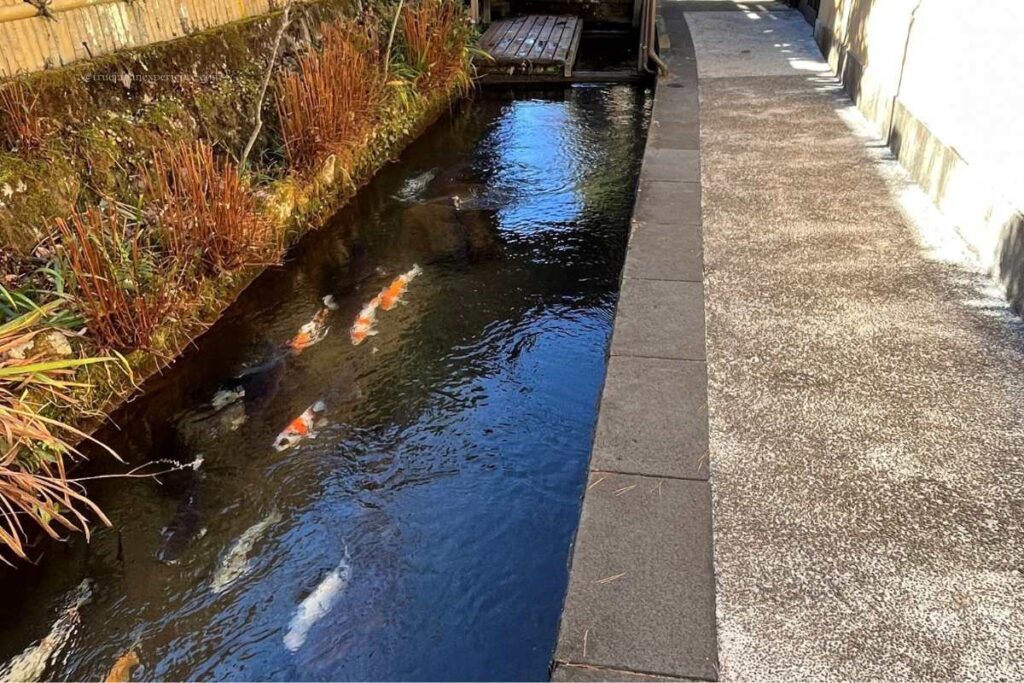
At the center of town, you’ll find Sogi-sui, a natural spring that was the very first place chosen for Japan’s “100 Famous Waters.” It’s a cool and peaceful spot to take a short break during your walk.
While walking around, be sure to visit Yanaka Mizu-no-Komichi and Igawa Komichi. These small paths run beside pretty canals and old houses. You can hear the water flow, feel the quiet air, and see the life of the town all around you.
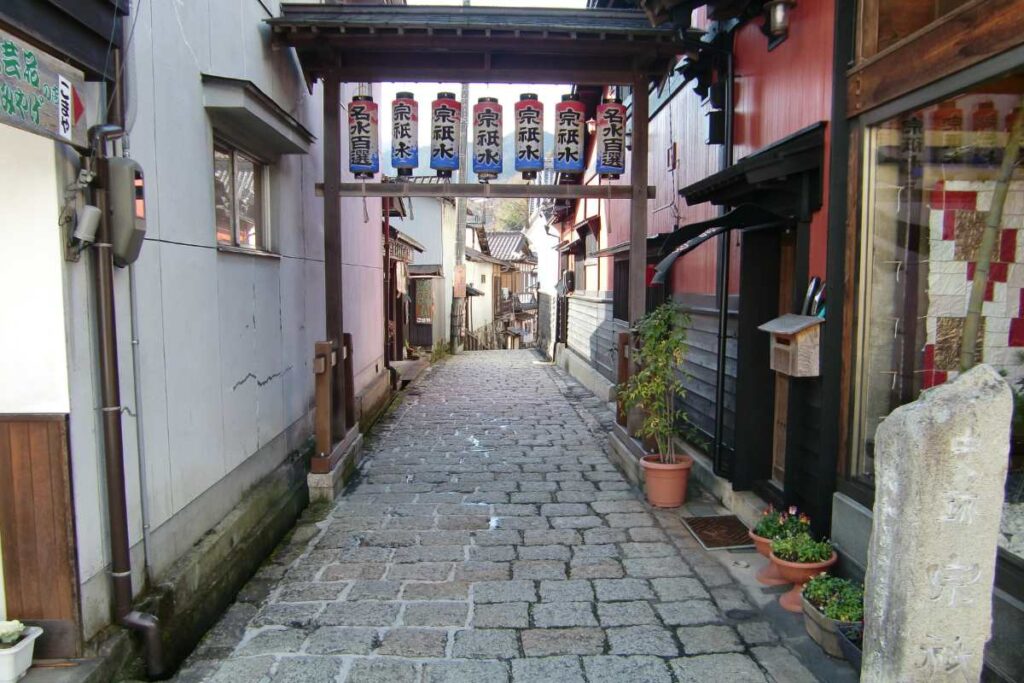
Wander down stone paths like Yanaka Mizu-no-Komichi and discover Gujo Hachiman’s rich connection to water.
Up on the hill stands Gujo Hachiman Castle, a beautiful wooden castle with a long history. From the top, you can see the town and green mountains all around. In the early morning, mist sometimes covers the town—making the castle look like it’s floating in the sky. That’s why people call it the “Castle in the Sky.”
Gujo Hachiman is known as the hometown of food sample making. You can visit workshops and try making a fake tempura or parfait that looks just like the real thing!
Don’t forget the food! Local dishes like grilled sweetfish (ayu), eel, handmade soba noodles, and a chicken dish called keichan are very tasty. Many shops use the fresh spring water in their cooking, so the flavors are clean and light.
Gujo Hachiman is more than just a festival town. It’s a place where nature, history, and warm people come together. It’s the perfect spot to enjoy before or after you join the dance.
How to Get to Gujo Hachiman
Gujo Hachiman is a small town in the mountains of Gifu Prefecture.
It doesn’t have a big train station or direct access by Shinkansen, so getting there takes a little extra planning. But with buses and local trains, you can still visit from major cities and airports.
It takes some planning to get there, but it’s a great trip for those who enjoy exploring lesser-known towns.
Highway buses and local trains are the most common ways.
From Gifu City
Take a highway bus from JR Gifu Station to Gujo Hachiman Jokamachi Plaza
→ It takes about 1 hour 30 minutes with buses every 90 minutes
If getting off at Gujo Hachiman IC (highway stop)
You need to walk about 30 minutes to the town center
→ Local buses or reservation taxis are available
From Gujo Hachiman Station
It’s about 20 minutes on foot to the center
→ Or take the Mame Bus, a small local bus
From Nagoya
Take a direct highway bus from Meitetsu Bus Center to Gujo Hachiman Jokamachi Plaza.
It takes about 1 hour 30 to 40 minutes, and the stop is near the town center.
If you use trains from Nagoya
Take the JR Hida Limited Express or JR Tokaido Line to Mino-Ota Station (about 40 minutes)
→ Then change to the Nagaragawa Railway and ride to Gujo Hachiman Station (about 80 minutes)
→ Total time: around 2.5 hours
Chubu Centrair Airport
Ride the Meitetsu Line to Nagoya Station (about 30 minutes)
→ Then continue by bus or train
From Tokyo
Take the Shinkansen from Tokyo Station to Nagoya Station (about 1 hour 45 minutes)
→ Then follow the Nagoya route above
From Osaka or Kyoto
Take the Shinkansen from Shin-Osaka or Kyoto to Nagoya Station (about 50 to 60 minutes)
→ Then continue from Nagoya
Gujo Hachiman is not on the Shinkansen line.
Extend Your Trip: Day Trips from Gujo Hachiman
If you have extra time after enjoying Gujo Hachiman, why not explore a little farther?
These beautiful places are even deeper in the mountains, so getting there takes more time—but they are truly worth the trip.
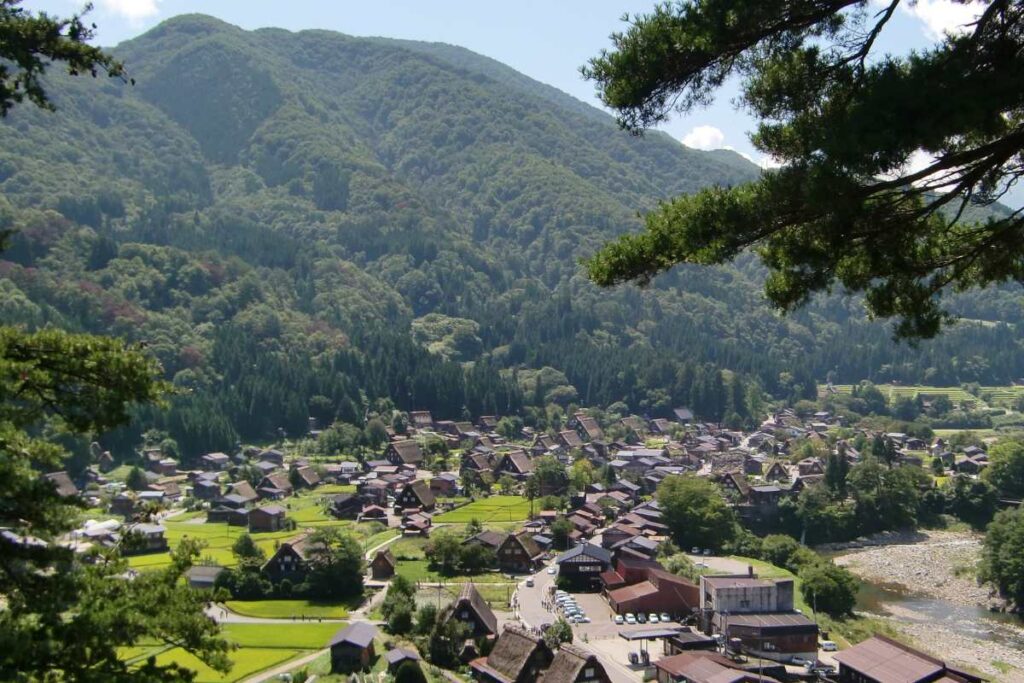
From the hilltop, you can enjoy a breathtaking view of the whole village and its peaceful mountain setting.
・Shirakawa-go(about 1 hour 10–35 minutes by bus)
This quiet village is famous for its old thatched-roof houses.
The buildings look like something from a fairy tale.
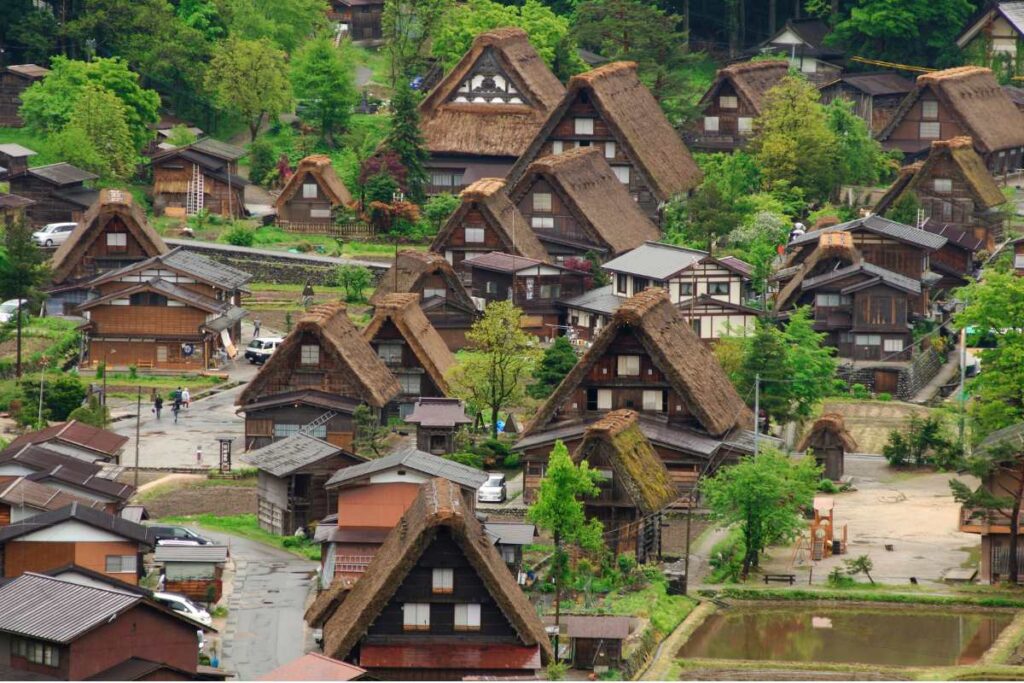
Shirakawa-go feels like a living fairy tale village, hidden deep in the mountains.
In every season—whether covered in snow or glowing in the summer sun—it feels like another world.
You can walk through the village, visit the homes, and enjoy the peaceful views of the countryside.
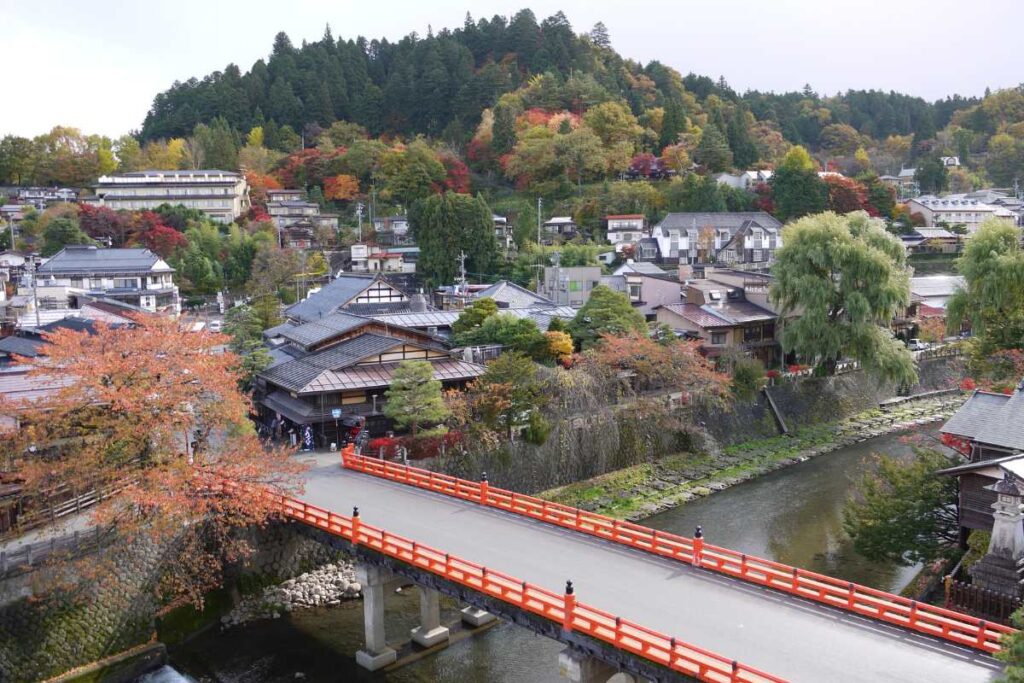
Takayama’s famous red bridge offers a perfect photo spot during the fall season.
・Takayama(about 1 hour 15–35 minutes by bus)
This small city is known for its traditional streets, morning markets, and handmade crafts.
It’s a great place to try local food, such as Hida beef, and see how life was in old Japan.
The town is full of history and charm, and easy to enjoy on foot.
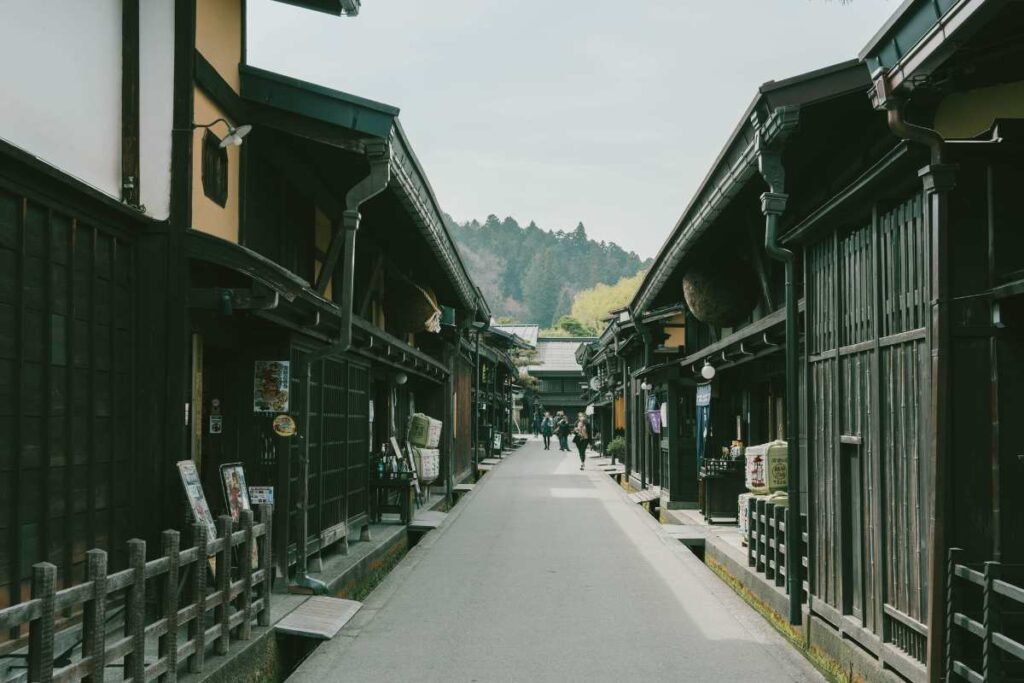
Takayama is known for its historic streets, morning markets, and beautiful mountain scenery.
There are only a few buses to Shirakawa-go and Takayama each day—sometimes just one. Make sure to check the schedule and reserve your seat early.
Please check the schedule and book early, especially in busy seasons.
These towns are not as easy to reach as big cities, but that’s part of what makes them special.
If you enjoy slow travel and quiet places, you will love these hidden gems of the Japanese mountains.
Final Thoughts
Gujo Odori is not just a show—it’s a living part of Japanese summer.
It’s where locals and strangers become friends, and where old streets come alive with music, laughter, and the sound of dancing feet.
You don’t need to know the steps. You don’t even need to wear a yukata.
Just step into the circle, and let the rhythm guide you.
It’s not the biggest or the flashiest festival.
But for us, it was one of the most unforgettable nights of our summer.
The kind of night that stays in your heart.
So if you ever find yourself in Japan during summer, don’t miss this.
Come dance with the people of Gujo Hachiman—and make a memory you’ll never forget.
If you love traditional festivals like Gujo Odori, why not explore more summer celebrations across Japan?
From the lively streets of Kyoto to fireworks over the Sumida River, July is full of unforgettable events.
▶︎ Celebrate Summer in Japan: Gion, Tenjin & Sumidagawa Festivals in July
